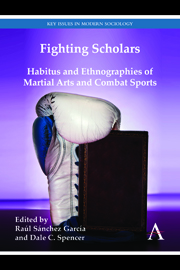Book contents
- Frontmatter
- Dedication
- Epigraph
- Contents
- Contributors
- Glossary
- Chapter 1 Introduction: Carnal Ethnography as Path to Embodied Knowledge
- Chapter 2 Habitus as Topic and Tool: Reflections on Becoming a Prizefighter
- Chapter 3 In Search of a Martial Habitus: Identifying Core Dispositions in Wing Chun and Taijiquan
- Chapter 4 Each More Agile Than the Other: Mental and Physical Enculturation in Capoeira Regional
- Chapter 5 ‘There Is No Try in Tae Kwon Do’: Reflexive Body Techniques in Action
- Chapter 6 ‘It Is About Your Body Recognizing the Move and Automatically Doing It’: Merleau-Ponty, Habit and Brazilian Jiu-Jitsu
- Chapter 7 ‘Do You Hit Girls?’: Some Striking Moments in the Career of a Male Martial Artist
- Chapter 8 The Teacher's Blessing and the Withheld Hand: Two Vignettes of Somatic Learning in South India's Indigenous Martial Art Kalarippayattu
- Chapter 9 White Men Don't Flow: Embodied Aesthetics of the Fifty-Two Hand Blocks
- Chapter 10 Japanese Religions and Kyudo (Japanese Archery): An Anthropological Perspective
- Chapter 11 Taming the Habitus: The Gym and the Dojo as ‘Civilizing Workshops’
- Chapter 12 ‘Authenticity’, Muay Thai and Habitus
- Chapter 13 Conclusion: Present and Future Lines of Research
- Epilogue Homines in Extremis: What Fighting Scholars Teach Us about Habitus
- References
Chapter 11 - Taming the Habitus: The Gym and the Dojo as ‘Civilizing Workshops’
Published online by Cambridge University Press: 05 March 2014
- Frontmatter
- Dedication
- Epigraph
- Contents
- Contributors
- Glossary
- Chapter 1 Introduction: Carnal Ethnography as Path to Embodied Knowledge
- Chapter 2 Habitus as Topic and Tool: Reflections on Becoming a Prizefighter
- Chapter 3 In Search of a Martial Habitus: Identifying Core Dispositions in Wing Chun and Taijiquan
- Chapter 4 Each More Agile Than the Other: Mental and Physical Enculturation in Capoeira Regional
- Chapter 5 ‘There Is No Try in Tae Kwon Do’: Reflexive Body Techniques in Action
- Chapter 6 ‘It Is About Your Body Recognizing the Move and Automatically Doing It’: Merleau-Ponty, Habit and Brazilian Jiu-Jitsu
- Chapter 7 ‘Do You Hit Girls?’: Some Striking Moments in the Career of a Male Martial Artist
- Chapter 8 The Teacher's Blessing and the Withheld Hand: Two Vignettes of Somatic Learning in South India's Indigenous Martial Art Kalarippayattu
- Chapter 9 White Men Don't Flow: Embodied Aesthetics of the Fifty-Two Hand Blocks
- Chapter 10 Japanese Religions and Kyudo (Japanese Archery): An Anthropological Perspective
- Chapter 11 Taming the Habitus: The Gym and the Dojo as ‘Civilizing Workshops’
- Chapter 12 ‘Authenticity’, Muay Thai and Habitus
- Chapter 13 Conclusion: Present and Future Lines of Research
- Epilogue Homines in Extremis: What Fighting Scholars Teach Us about Habitus
- References
Summary
Introduction
In this chapter I bring in Norbert Elias's notion of habitus applied to ethnographic settings (the boxing gym and aikido dojo). Complemented by other conceptual tools such as ‘tension balance’, ‘thresholds of violence’ or ‘double-bind process’, I try to contribute in the advance towards the possibility of a real ‘carnal sociology’ (Wacquant 2005a, 2011). Even though Elias's usage of habitus is less well known than Bourdieu's, I argue that it is as important as a topic of research (especially when dealing with martial arts and combat sports) and as a tool for conducting ethnographic studies. In both Bourdieu and Elias, the notion of habitus refers to some kind of tacit disposition, a kind of ‘second nature’ that allows a pre-reflective relation to the world affected by the social conditions of its production. Nonetheless, there are some differences. Whereas in Bourdieu (1990b, 2000; Bourdieu and Wacquant 1992), the notion of habitus implies a whole common sense, a way of perceiving and acting, in Elias, the notion of habitus is restricted to the balance between spontaneity and constriction in the expression of affects and emotions. This difference does not prevent both notions from being complementary. On the contrary: as we can see in Wacquant's study of boxing in Chicago (Wacquant 2004a), the specific conditions of being/learning in the gym affects the whole common sense of boxers but also the way they express and control their affections, especially (but not only) those related to violence.
- Type
- Chapter
- Information
- Fighting ScholarsHabitus and Ethnographies of Martial Arts and Combat Sports, pp. 155 - 170Publisher: Anthem PressPrint publication year: 2013

